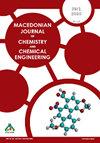Optimization and kinetic study of anthraquinone dye removal from colored wastewater using soybean seed as a source of peroxidase for environmental welfare
IF 1.1
4区 化学
Q3 CHEMISTRY, MULTIDISCIPLINARY
Macedonian Journal of Chemistry and Chemical Engineering
Pub Date : 2020-11-26
DOI:10.20450/mjcce.2020.2150
引用次数: 3
Abstract
As water contamination emerges as a serious threat to the environment, ventures for cleaner and sustainable solutions are continuously being developed. The present study investigates the ability of crude peroxidase extract from soybean seeds to degrade the anthraquinone dye Acid Violet 109. The influence of the essential parameters pH, dye concentration, hydrogen peroxide dosage, and temperature were inspected. The enzyme had 81.9 % biodegradation at pH 4 in 30 min with 0.1 U peroxidase, 40 mg/l dye concentration, and 1 mM hydrogen peroxide. Considering that substrate concentration can cause reaction inhibition, a kinetic study was performed. Kinetic data fitting using bisubstrate kinetics with a substrate inhibition model revealed the high inhibitory effect of the dye, which was confirmed by the inhibition constant, 7.123·10 –5 mM. Alongside the inhibition constant values, the Ping-Pong Bi-Bi model gave the maximum rates 15.788 and 14.321 mM/min for hydrogen peroxide and dye inhibition, respectively.以大豆种子为过氧化物酶源去除有色废水中蒽醌染料的工艺优化及动力学研究
随着水污染成为对环境的严重威胁,正在不断开发更清洁和可持续的解决方案。研究了大豆种子过氧化物酶粗提物对蒽醌染料酸性紫109的降解能力。考察了基本参数pH、染料浓度、过氧化氢用量和温度对染料性能的影响。用0.1U过氧化物酶、40mg/l染料浓度和1mM过氧化氢,该酶在pH 4下30分钟内具有81.9%的生物降解率。考虑到底物浓度会引起反应抑制,进行了动力学研究。使用双底物动力学和底物抑制模型拟合的动力学数据显示了染料的高抑制作用,抑制常数7.123·10–5 mM证实了这一点。除了抑制常数值外,Ping Pong Bi-Bi模型对过氧化氢和染料的抑制分别给出了15.788和14.321 mM/min的最大速率。
本文章由计算机程序翻译,如有差异,请以英文原文为准。
求助全文
约1分钟内获得全文
求助全文
来源期刊
CiteScore
1.60
自引率
20.00%
发文量
14
审稿时长
>12 weeks
期刊介绍:
Macedonian Journal of Chemistry and Chemical Engineering (Maced. J. Chem. Chem. Eng.) is an official publication of the Society of Chemists and Technologists of Macedonia. It is a not-for-profit open acess journal published twice a year. The journal publishes original scientific papers, short communications, reviews and educational papers from all fields of chemistry, chemical engineering, food technology, biotechnology and material sciences, metallurgy and related fields. The papers published in the Journal are summarized in Chemical Abstracts.

 求助内容:
求助内容: 应助结果提醒方式:
应助结果提醒方式:


